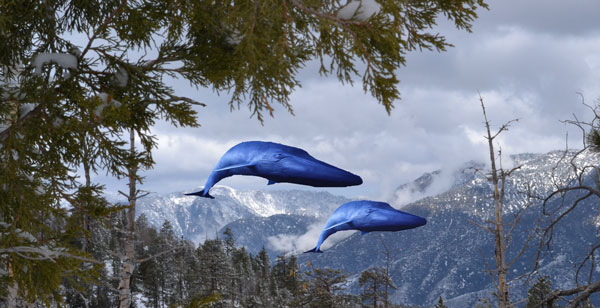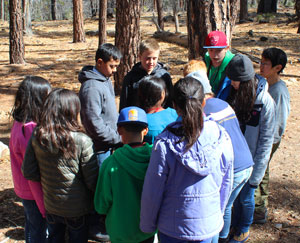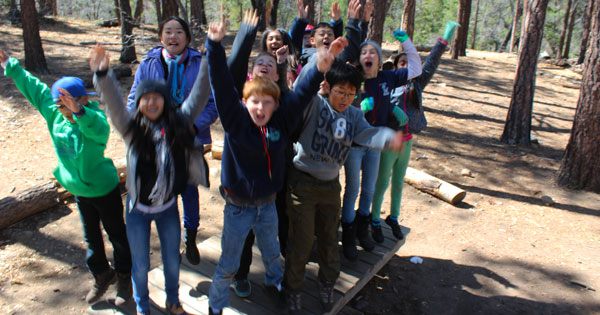What could possibly be going on here? Adventure Course at High Trails, that’s what. During a high climbing, arrow shooting, wander about the woods day, most students are lucky enough to get lost in a fantasy story while participating in our low elements course. What is a low elements course, and why do we use them?

Low elements are classified as activities that start on the ground and up to twelve feet. It is also characterized by the safety mechanism called “spotting” instead of harnesses and ropes. The goals become more complex and the group begins to take larger risks as the activities continue. Some low elements are valuable for teaching teamwork and cooperation, while others are concerned with balance and concentration. All of our low elements here at High Trails are less than 2 feet off the ground.

People have asked why we even have a low ropes course at a science school, which is a respectable question. We have one because these elements help foster trust, respect, care, and concern for every person, and this supports our mission statement. Within the Adventure Course, we want our students to improve and develop their skills and abilities in three learning domains: affective, psychomotor, and cognitive. These domains can be thought of as categories of learning.
Affective is for growth in feelings or emotional areas, psychomotor is for the manual or physical skills, and cognitive is for mental skills.
Adventure Course is a class in which students are challenged, as an individual and as a member of a team or group. While our students are participating in Adventure Course they are using their minds just as much, if not more, than their bodies. They will be working together with classmates to achieve a common goal with subsequent rewards. This class concentrates a lot on problem solving and teamwork. As teachers, we will make sure that each student is involved and doing their part in the problem solving and their part with their group and/or team. These two concepts are not only important in the Adventure Course, but also in everyday situations.
 Within the affective domain, which includes the manner in which we deal with things emotionally, such as feelings, values, appreciation, enthusiasm, motivations, and attitudes, students are asked to work cooperatively with one or more partners/classmates. They are placed in an environment where they must depend on their groups.
Within the affective domain, which includes the manner in which we deal with things emotionally, such as feelings, values, appreciation, enthusiasm, motivations, and attitudes, students are asked to work cooperatively with one or more partners/classmates. They are placed in an environment where they must depend on their groups.
During this class, students learn how to follow directions, be responsible, safe, and will have to deal with consequence of their actions. Moreover, we are expecting the students to have a positive attitude and enjoy themselves. Here at High Trails on the Whale Watch initiative, students are excited they accomplished their goal and have a plan come together.
 In regards to the psychomotor domain, which includes physical movement, coordination, and use of the motor-skill areas, our students learn and sometimes help with proper techniques and skills as they are needed in the activities. To be successful in these activities, students will have to move and be active. The games and activities taught will not only be beneficial in the class, but throughout their lives within many different settings. During the Nitro Crossing initiative, our students have to make a good plan, but also be able to swing across a space to a platform.
In regards to the psychomotor domain, which includes physical movement, coordination, and use of the motor-skill areas, our students learn and sometimes help with proper techniques and skills as they are needed in the activities. To be successful in these activities, students will have to move and be active. The games and activities taught will not only be beneficial in the class, but throughout their lives within many different settings. During the Nitro Crossing initiative, our students have to make a good plan, but also be able to swing across a space to a platform.
Lastly, the cognitive domain involves knowledge and the development of intellectual skills. The group is challenged with different mental problems. These problems will challenge the class as individuals, partners, groups, or even as a whole. Students will be expected to follow the group rules, the safety statement, and the needs of the other students. While on the High Trails’ adventure course, students are given the chance plan together before attempting a challenge. This allows them to work together and learn the importance of teamwork.
Our Adventure Course has a variety of each type of element for a balanced presentation of all the skills and confidence levels in the group. Learning in a group environment can be powerful when coupled with reflection and transference into daily living situations. Some of our elements are portable and can be used indoors when we have inclement weather.

With so many benefits for team building, many organizations have been using low ropes as an education tool. As a former coach, I had my teams participate in a low ropes course for a day, every year. It almost forces students to work together if they want to achieve their goal. Professional, collegiate, high school, and even elementary level classes and teams use low elements for the growth of their team.
At High Trails Outdoor Science School, we literally force our instructors to write about elementary outdoor education, teaching outside, learning outside, our dirty classroom (the forest…gosh), environmental science, outdoor science, and all other tree hugging student and kid loving things that keep us engaged, passionate, driven, loving our job, digging our life, and spreading the word to anyone whose attention we can hold for long enough to actually make it through reading this entire sentence. Whew…. www.dirtyclassroom.com

Comments are closed.